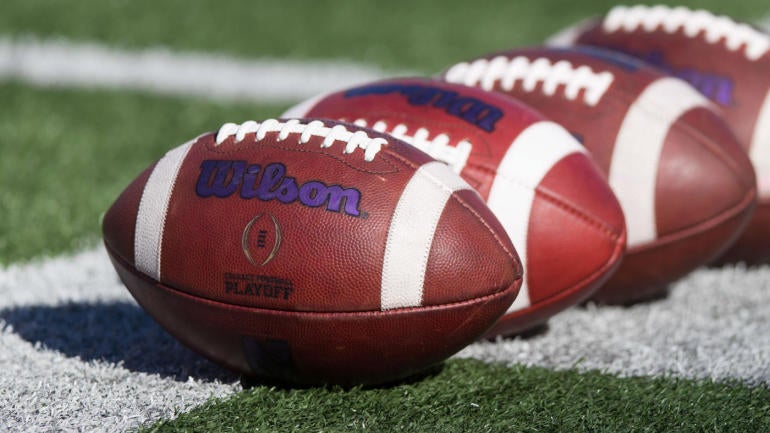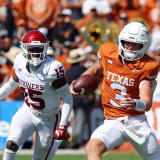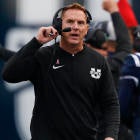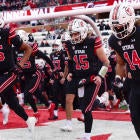
College football's National Signing Day is just a week away. On Wednesday, Feb. 3, college prospects from the Class of 2021 who did not sign during the early signing period in December have the option to send in their National Letters of Intent (NLI).
The vast majority of top prospects did sign with schools during the that early period, however. Of the 358 prospects rated four stars or better in the 247Sports Composite, only 30 remain unsigned. And of those 30, a significant number have committed within the last three weeks, intending to formally sign on National Signing Day.
Last week in this space, I profiled 10 prospects who are expected to sign in the next few weeks. Since that writing, running back Byron Cardwell picked Oregon, while offensive lineman Josh Simmons picked San Diego State.
This is now the fourth year of college football with the early and traditional signing days. And with the benefit of time, there are some takeaways we can draw. Let's take a look and what we know -- and what we can expect -- over the next week.
The traditional National Signing Day is now a catch-all
With almost all of the top prospects electing to sign early, there is far less drama on National Signing Day. While not all prospects are ready to sign, coaches are eager to get them inked. And most coaches with whom I speak believe that, with few exceptions, a prospect who is verbally committed but unwilling to sign is not actually committed to the school. (That's with exceptions for other outstanding issues, such as grades.) While some prospects are happy to get the process over, others feel pressure to sign before they are fully ready. That could be one reason why the transfer portal has been even busier than initially expected.
Early signing + coaching changes = unintended consequences
In theory, the early period is a great idea, and it has been a success for many schools and players. But one area in which is has been a failure is how it meshes with the timing of coaching changes. Back when National Signing Day was the only signing time, almost all coaching changes had been made. Few head coaches or coordinators are fired or changed after February, and coaching staffs hired in early December had roughly two months to figure out just what they had in committed prospects, plus who was left on the board.
Now, coaches sometimes have less than two weeks to formulate a game plan, meet their committed players, make decisions on whether to keep those verbally committed players and try to add new recruits to their early signing class. That's a difficult process, one which leads to sky-high attrition rates in the first classes signed by a new coaching staff. They try to make due with the traditional National Signing Day, but it is tough.
What's worse is the huge number of coaching changes which come after the early period. This after players, who were reassured that they would be playing for a certain staff, have already signed with programs.
Take Texas, for example. Texas fired Tom Herman just three weeks after the early period once recruits had been reassured that Herman would be the coach. I wrote that any Texas signee who wants to be released from his NLI should be granted one. If a school does not elect to grant such a release, the penalty is that the athlete must sit out a year at whichever new school at which he elects to enroll.
This isn't just a Texas thing, of course. Tennessee's top signee, Dylan Brooks, asked for his release after the Vols fired Jeremy Pruitt. The status of that request has not been reported publicly.
Given the amount of bait-and-switch going on due to the onset of the early period and the unchanged timeline of coaching firings and hirings, it is clear that certain criteria should be in place where the release is automatically granted, as opposed to leaving it up to a school. I'd make it so that if a recruit's head coach leaves before his first season begins, he can leave without penalty. And I'd be open to arguments that extend that protection to the coordinator on his side of the football, given that new schemes can drastically impact a prospect's future.
Amid the pandemic, schools turn to the portal
The 2021 college football recruiting cycle has already been unlike any other in modern times. Due to the COVID-19 pandemic, college football teams and recruits scrambled to find out information about one another. There were no on-campus camps, official visits, in-home visits or opportunities to see prospects work out in person. How big is a player, really? What are he and his family truly like? Is one school's campus and culture actually a better fit than another?
The best schools are still loading up on the best high schoolers. But for programs who are outside the current top five recruiting classes, it can be a bit of a different story. Some are leaving a lot of spots open for transfers. That's because transfers, just like recruits, count against the cap of 25 new players a school may bring in in a given year. And this year, transfers are immediately eligible.
"If it is a borderline recruit for us, we'd rather take a transfer who we know can cut it physically at the college level," said one staffer.
Many coaches and recruiting personnel have echoed those sentiments. Their thought is this: Why not take a transfer player who can be OK for two years and get that scholarship back quickly to use on a future recruit as opposed to risking a four-year mistake on a borderline high school prospect you've never worked out or seen in person? Coaches think the bust rate in this 2021 high school class might be much higher than normal due to the lack of evaluation and development time.
Take Oklahoma, North Carolina, Penn State and Florida State, which only signed an average of 16 players in the early cycle. Oklahoma has three transfers as of this writing. Penn State has four, while FSU has eight already.
With so many schools signing five or more fewer high schoolers than they normally would, doesn't that mean the talent will likely trickle down? If the top 25 or so schools leave an average of two extra spots open for transfers, that's 50 high school prospects who would otherwise not be available for some lesser programs to sign who are suddenly available.
"There's no doubt," a scouting director said on Monday. "If you are at a G5 school and you know your athletic director will be patient with you, there is absolutely an opportunity to sign some prospects who would normally be signed as flyers by P5 programs. It should trickle down to FCS schools, too."
Having some scholarships unfilled leading up to National Signing Day also allows for a school to identify and sign late bloomers. And 2021 is ripe for prospects to emerge later in the cycle due to the lack of camps and combines over the summer. I wrote recently about two such players in Antonio Jamison Jr. and Khalil Harris, who I saw over the weekend at a 7-on-7. I believe they would have been seen by more colleges had the camp and combine circuit been available over the summer as it normally would in a non-pandemic year.















